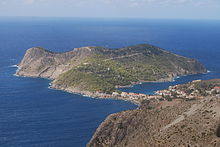Isthmus
![]()
This article or section is still missing the following important information:
Distinction from tombolo, at what point is an isthmus not a tombolo?
Help Wikipedia by researching and adding them.
An isthmus (from ancient Greek ἰσθμός isthmós "isthmus" "isthmus") is the narrowest point of a land bridge bounded on both sides by water and connecting two major land masses. The term isthmus is also in common use. An isthmus is often a suitable place for the construction of a canal, as here the distance to be covered by the canal is the smallest. Outstanding examples of this are the Corinth Canal and the Panama Canal, both of which drastically reduce the length of certain shipping links, but also the historic Xerxes Canal.
In former times Isthmuses were preferred places to transport ships from one sea to the other over land. Thus Thucydides had already testified that ships were towed across the Isthmus of Corinth. Homer's description of the two ports of the Phaiaks separated by land: "... ships are dragged up a way; for all of them have each a rack" could refer to an isthmus. According to a theory of Armin Wolf, the passage could refer to the Isthmus of Calabria (isthmus of Tiriolo), where a land distance of only 3500 meters had to be overcome from the Tyrrhenian Sea to the Ionian Sea by using the rivers.
The counterpart to the isthmus as a connection of land masses is the strait or straitway as a narrow connection of two seas (e.g. the Strait of Gibraltar).

Asos on Kefalonia, Greece

An isthmus of sand (tombolo) connects the northern and southern parts of Bruny Island near Tasmania.
See also
- List of Isthmuses
- Tombolo
- Spit
- Portage (Canoe)
Search within the encyclopedia